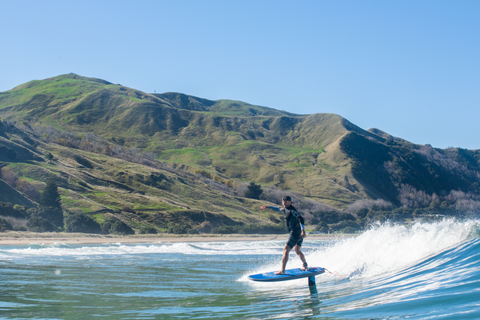What started Foil Paddleboarding
In 2016, Kai Lenny, a prominent Hawaiian surfer, stand-up-paddler, windsurfer, and kitesurfer approached Alex Aguera of GoFoil with an unusual request. He wanted him to attach a foil to a stand-up paddleboard. After playing around with a few designs, Aguera obliged him by mounting a foil on a 315 cm paddleboard, and the first Hydrofoil SUP was born.
As soon as Kai tried out the new board, he knew he was looking at the future of SUP racing. A video of him using his new board was published by SUP magazine, and went spectacularly viral, cementing his place in the history of the sport. Since then, foil SUPs have exploded in popularity, with companies rushing to improve and perfect different designs, and watersports enthusiasts everywhere racing to test their limits. Other board sports—such as wing surfing—have also adopted the foil to introduce an entirely new element with the New Wing, allowing people to foil on flat waters.
How it works
Unlike a regular paddleboard, a foil SUP will lift the paddler up above the water as waves move underneath, lending the board their energy. This allows the board to move much faster, first by harnessing the energy of waves to push the board up and forward, and secondly by reducing drag as the board is lifted off the surface of the water.

The “foil” in this case refers to a hydrofoil. Hydrofoils are lifting surfaces that work roughly like the wing of an airplane, except underwater. While they’ve been used in kite surfing for some time, Kai Lenny was the first to think to attach one to a SUP. This is likely because getting up onto the foil requires quite a bit of a push. The first hydrofoils were used to lift fast-moving powered boats out of the water, and those later adapted to kite surfing harnessed the wind to provide the necessary power.
Kai, who had experience in downwind SUP as well as traditional surfing, realised that there was plenty of energy to capture in the water itself. By getting the board up onto a swell, the hydrofoil would catch the wave and get the needed acceleration to lift it out of the water.
Why foil paddleboards caught on so quickly
Foil paddleboards have caught on remarkably quickly. In just 3 years, foil paddleboards have become a global phenomenon, with paddleboarders from the US, to Europe, to New Zealand taking to them like a fish to water. This is partly because of their obvious fun factor, but also because of their accessibility.

Not only does it feel like the next best thing to human flight, foil paddleboards are nearly as accessible as traditional paddleboards in terms of where they can be used. All it takes is a foil board, and a sufficient means of propulsion to get up out of the water. Ideally this will be a natural means, like a wave, but if there isn’t enough wind to create sufficient swells, a boat or jet ski can also be used to accelerate the board.
The future of foil paddleboarding
Foils have added an exciting new element to paddleboarding, but it’s still a relatively recent innovation. At this time, foils are mostly only accessible to dedicated paddleboarders who are willing to buy their own. More casual paddleboarders, who rely on rentals, or those who may just want to try it out, can look forward to the continuing proliferation and improved accessibility of foils for mainstream use in the coming years.
For those who usually prefer paddling in calmer waters, the first self-propelled eFoils hit the market in 2018, though these may actually no longer qualify as a real paddleboard since they don’t actually require the use of a paddle. What is clear is that foil boards have expanded—and continue to expand—the limits of what paddleboards are capable of, and are here to stay.


